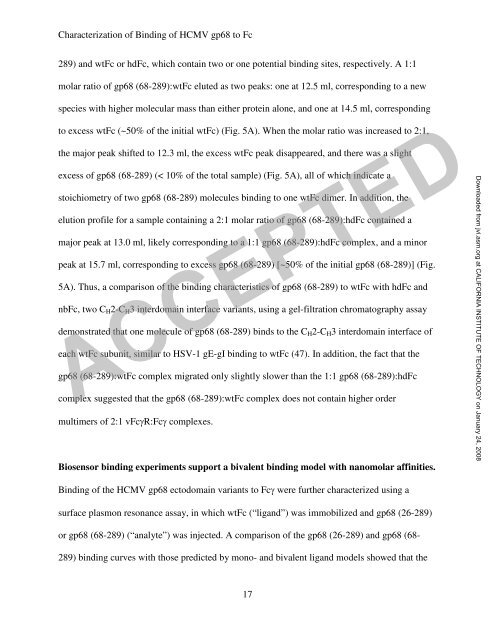The Human Cytomegalovirus Fc Receptor gp68 Binds the Fc CH2 ...
The Human Cytomegalovirus Fc Receptor gp68 Binds the Fc CH2 ...
The Human Cytomegalovirus Fc Receptor gp68 Binds the Fc CH2 ...
You also want an ePaper? Increase the reach of your titles
YUMPU automatically turns print PDFs into web optimized ePapers that Google loves.
Characterization of Binding of HCMV <strong>gp68</strong> to <strong>Fc</strong><br />
289) and wt<strong>Fc</strong> or hd<strong>Fc</strong>, which contain two or one potential binding sites, respectively. A 1:1<br />
molar ratio of <strong>gp68</strong> (68-289):wt<strong>Fc</strong> eluted as two peaks: one at 12.5 ml, corresponding to a new<br />
species with higher molecular mass than ei<strong>the</strong>r protein alone, and one at 14.5 ml, corresponding<br />
to excess wt<strong>Fc</strong> (~50% of <strong>the</strong> initial wt<strong>Fc</strong>) (Fig. 5A). When <strong>the</strong> molar ratio was increased to 2:1,<br />
<strong>the</strong> major peak shifted to 12.3 ml, <strong>the</strong> excess wt<strong>Fc</strong> peak disappeared, and <strong>the</strong>re was a slight<br />
excess of <strong>gp68</strong> (68-289) (< 10% of <strong>the</strong> total sample) (Fig. 5A), all of which indicate a<br />
stoichiometry of two <strong>gp68</strong> (68-289) molecules binding to one wt<strong>Fc</strong> dimer. In addition, <strong>the</strong><br />
elution profile for a sample containing a 2:1 molar ratio of <strong>gp68</strong> (68-289):hd<strong>Fc</strong> contained a<br />
major peak at 13.0 ml, likely corresponding to a 1:1 <strong>gp68</strong> (68-289):hd<strong>Fc</strong> complex, and a minor<br />
peak at 15.7 ml, corresponding to excess <strong>gp68</strong> (68-289) [~50% of <strong>the</strong> initial <strong>gp68</strong> (68-289)] (Fig.<br />
5A). Thus, a comparison of <strong>the</strong> binding characteristics of <strong>gp68</strong> (68-289) to wt<strong>Fc</strong> with hd<strong>Fc</strong> and<br />
nb<strong>Fc</strong>, two C H 2-C H 3 interdomain interface variants, using a gel-filtration chromatography assay<br />
demonstrated that one molecule of <strong>gp68</strong> (68-289) binds to <strong>the</strong> C H 2-C H 3 interdomain interface of<br />
ACCEPTED<br />
each wt<strong>Fc</strong> subunit, similar to HSV-1 gE-gI binding to wt<strong>Fc</strong> (47). In addition, <strong>the</strong> fact that <strong>the</strong><br />
<strong>gp68</strong> (68-289):wt<strong>Fc</strong> complex migrated only slightly slower than <strong>the</strong> 1:1 <strong>gp68</strong> (68-289):hd<strong>Fc</strong><br />
complex suggested that <strong>the</strong> <strong>gp68</strong> (68-289):wt<strong>Fc</strong> complex does not contain higher order<br />
multimers of 2:1 v<strong>Fc</strong>γR:<strong>Fc</strong>γ complexes.<br />
Biosensor binding experiments support a bivalent binding model with nanomolar affinities.<br />
Downloaded from jvi.asm.org at CALIFORNIA INSTITUTE OF TECHNOLOGY on January 24, 2008<br />
Binding of <strong>the</strong> HCMV <strong>gp68</strong> ectodomain variants to <strong>Fc</strong>γ were fur<strong>the</strong>r characterized using a<br />
surface plasmon resonance assay, in which wt<strong>Fc</strong> (“ligand”) was immobilized and <strong>gp68</strong> (26-289)<br />
or <strong>gp68</strong> (68-289) (“analyte”) was injected. A comparison of <strong>the</strong> <strong>gp68</strong> (26-289) and <strong>gp68</strong> (68-<br />
289) binding curves with those predicted by mono- and bivalent ligand models showed that <strong>the</strong><br />
17
















